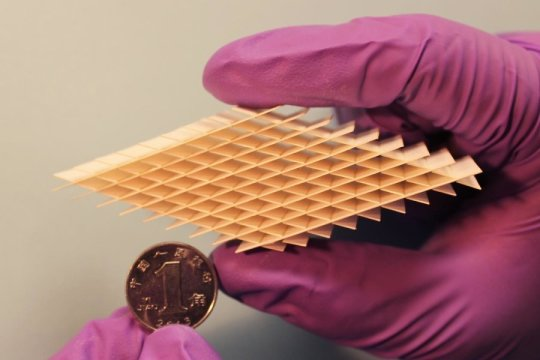By Jon Gabay, contributing writer
The newest wearable technologies, as well as the implantable options to come, will connect people with their machines on a deeper level than ever before. Already, medical devices are implantable for prolonged periods while providing data and communications. As more medical and recreational technologies implant within us, extracting electrical energy from the body is the only way to make this process sustainable and long-term.
New research at American Chemical Society has demonstrated some new energy-generating structures based on Chinese and Japanese paper-folding techniques. Key is that these ultra-lightweight energy-producing structures also store energy.
Called triboelectric nanogenerators (TENGs), they are rhombic paper-cut designs a few inches long that basically make up a supercapacitor using gold- and graphite-coated sandpaper on one side. The other side is the energy capture coatings of gold and fluorinated ethylene propylene film that has been shown to generate a volt through the pressing and releasing action. While still a slow and inefficient energy, taking several minutes to charge, once refined and enhanced, this lightweight and low-cost coated paper could provide virtually free energy. Although not presently ready for prime time, there is promise because it can capture and store energy.

Based on Chinese and Japanese folding and cutting techniques, the triboelectric nanogenerator can be cut and shaped to fit into our lifestyle and provide energy harvesting and storage from our body movements. Image source: American Chemical Society.
While the TENG falls under the energy-harvesting umbrella, it is one of the many technologies positioning itself for the wearable and implantable technologies to come. Included so far are viable photoelectric cells, thermoelectric devices, heat pumps, Peltier Effect devices, piezoelectric, and mechanical-to-electric systems like the TENG.
What makes the TENG different is the capture and storage of energy in a single construct. Being made of paper like coated materials means that it can easily be cut and shaped to fit more form factors more easily. The flexibility inherent in its construction also allows it to exhibit survivability to other hardened energy-harvesting techniques that are rigid and fragile like crystals.
Like real estate, the three most important factors when using TENG is location, location, and location. This technology needs to flex and be put under pressure and released several times to generate power. This means that embedded in an elbow joint, knee joint, or shoulder joint may give it a more constant influx of raw mechanical motion to convert.
One technique is to use the pads and balls of the foot coupled through a TENG unit in the base of the shoe. This can transmit a pulse of energy every time that steps are taken. This could couple to the embedded coils in the foot pads and transfer walking energy into electrical energy inside the body.
A note about energy transfer: While wearables can wire directly to charge from motion, implantables cannot. Unless the TENG is implanted inside the body, collected electrical energy from worn clothing or apparatuses will need to transfer energy to devices inside the body.
It is possible to use wireless charging pads that you strap on and wear when you need to recharge. Like an elastic ace bandage, coils align and energy transfers. You need a source of energy to run the wireless charger, but this is a doable approach to sustaining, say, multiple medical-monitoring and medication-dispensing systems implanted within a body.
If the energy itself can come from inside the body, then that is the best solution. Most people think of the brain as the most energetic organ, but in fact, it’s the heart. The heart generates hundreds of times more electrical energy than does the brain. But taxing a heart with a mechanically coupled generator does not seem like a rational approach.
Making TENG-based elastic artery sections that can tap and resonate with the natural movements of the body itself may ultimately provide a constant source of electricity.
Since studying electrical engineering, Jon Gabay has worked with defense, commercial, industrial, consumer, energy, and medical companies as a design engineer, firmware coder, system designer, research scientist, and product developer. As an alternative energy researcher and inventor, he has been involved with automation technology since he founded and ran Dedicated Devices Corp up until 2004. Since then, he has been doing research and development, writing articles, and developing technologies for next-generation engineers and students.
Advertisement
Learn more about Electronic Products Magazine





